

Compact Muon Solenoid
LHC, CERN
| CMS-HIN-20-002 ; CERN-EP-2023-294 | ||
| Elliptic anisotropy measurement of the f$_0$(980) hadron in proton-lead collisions and evidence for its quark-antiquark composition | ||
| CMS Collaboration | ||
| 28 December 2023 | ||
| Submitted to Nature Physics | ||
| Abstract: Despite the f$_0$(980) hadron having been discovered half a century ago, the question about its quark content has not been settled: it might be an ordinary quark-antiquark ($ \mathrm{q}\bar{\mathrm{q}} $) meson, a tetraquark ($ \mathrm{q}\bar{\mathrm{q}}\mathrm{q}\bar{\mathrm{q}} $) exotic state, a kaon-antikaon ($ \mathrm{K}\overline{\mathrm{K}} $) molecule, or a quark-antiquark-gluon ($ \mathrm{q}\bar{\mathrm{q}}\mathrm{g} $) hybrid. This paper reports strong evidence that the f$_0$(980) state is an ordinary $ \mathrm{q}\bar{\mathrm{q}} $ meson, inferred from the scaling of elliptic anisotropies ($ v_{2} $) with the number of constituent quarks ($ n_{\mathrm{q}} $), as empirically established using conventional hadrons in relativistic heavy ion collisions. The f$_0$(980) state is reconstructed via its dominant decay channel $ \mathrm{f}_0(980) \to \pi^{+}\pi^{-} $, in proton-lead collisions recorded by the CMS experiment at the LHC, and its $ v_{2} $ is measured as a function of transverse momentum ($ p_{\mathrm{T}} $). It is found that the $ n_{\mathrm{q}} = $ 2 ($ \mathrm{q}\bar{\mathrm{q}} $ state) hypothesis is favored over $ n_{\mathrm{q}} = $ 4 ($ \mathrm{q} \bar{\mathrm{q}} \mathrm{q} \bar{\mathrm{q}} $ or $ \mathrm{K}\overline{\mathrm{K}} $ states) by 7.7, 6.3, or 3.1 standard deviations in the $ p_{\mathrm{T}} < $ 10, 8, or 6 GeV/$c$ ranges, respectively, and over $ n_{\mathrm{q}}= $ 3 ($ \mathrm{q}\bar{\mathrm{q}}\mathrm{g} $ hybrid state) by 3.5 standard deviations in the $ p_{\mathrm{T}} < $ 8 GeV/$c$ range. This result represents the first determination of the quark content of the f$_0$(980) state, made possible by using a novel approach, and paves the way for similar studies of other exotic hadron candidates. | ||
| Links: e-print arXiv:2312.17092 [hep-ex] (PDF) ; CDS record ; inSPIRE record ; CADI line (restricted) ; | ||
| Figures | |
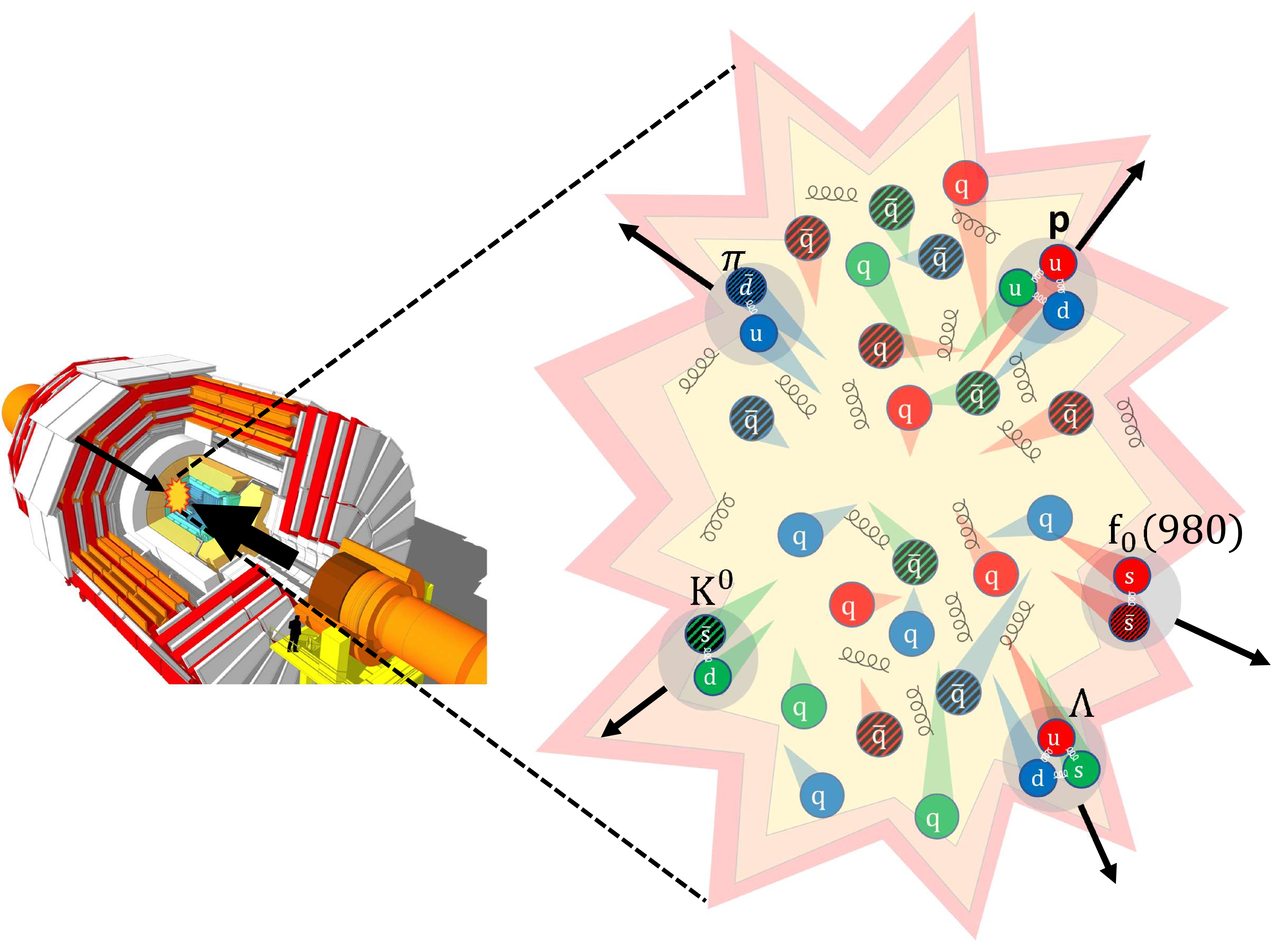
png pdf |
Figure 1:
Coalescence hadronization. This picture illustrates the formation of hadrons in heavy ion collisions in the coalescence model. Hadrons tend to form when the constituent quarks have similar positions and momenta. |

png pdf |
Figure 2:
Elliptic anisotropy results. The nonflow-effect-subtracted elliptic anisotropy $ v_2^{\text{sub}} $ of the f$_0$(980) is shown as a function of $ p_{\mathrm{T}} $ within $ |y| \lesssim $ 2.4 in high-multiplicity $ \mathrm{p}\mathrm{Pb} $ collisions. The error bars show statistical uncertainties while the shaded areas represent systematic uncertainties. |
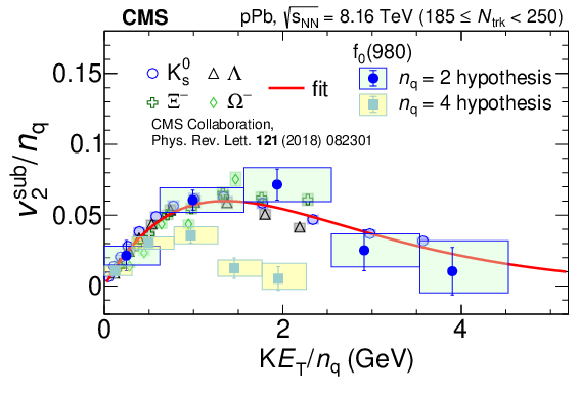
png pdf |
Figure 3:
NCQ scaling of elliptic anisotropy. The $ v_2^{\text{sub}}/n_{\mathrm{q}} $ of the f$_0$(980) state (for the $ n_{\mathrm{q}}= $ 2 and 4 hypotheses) as a function of $ KE_{\text T}/n_{\mathrm{q}} $, compared with those of $ \mathrm{K^0_S} $, $ \Lambda $, $ \Xi^{-} $, and $ \Omega $ strange hadrons [50] in high-multiplicity $ \mathrm{p}\mathrm{Pb} $ collisions. The error bars show statistical uncertainties while the shaded areas represent systematic uncertainties. The red curve is the NCQ scaling parameterization of the data for $ \mathrm{K^0_S} $, $ \Lambda $, $ \Xi^{-} $, and $ \Omega $ hadrons given by Eq. \eqrefequ:ncq. |

png pdf |
Figure 4:
Exclusion significance from $ n_{\mathrm{q}}= $ 4. The log-likelihood ratio distributions for the $ n_{\mathrm{q}}= $ 2 and 4 hypotheses from pseudo-experiments, together with the measured value for the f$_0$(980) state in the 0 $ < p_{\mathrm{T}} < $ 10 GeV/$c$ range. |
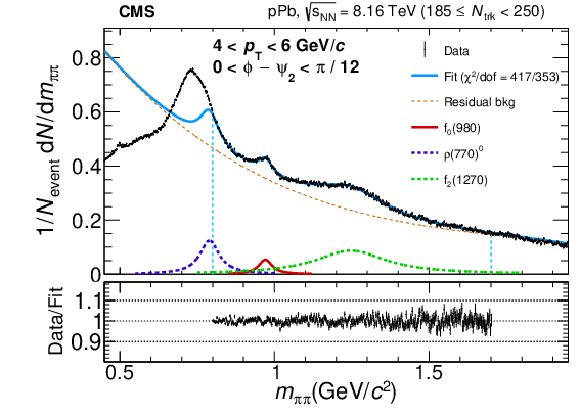
png pdf |
Figure 5:
Invariant mass fit. The invariant mass spectrum of opposite-sign pion pairs after the combinatorial background subtraction, for the pair transverse momentum 4 $ < p_{\mathrm{T}} < $ 6 GeV/$c$ and the azimuthal angle 0 $ < \phi-\psi_{2} < \pi/ $ 12, in high-multiplicity $ \mathrm{p}\mathrm{Pb} $ collisions. The solid blue curve is the fit result within the fit range marked with vertical blue dashed lines; the orange dashed curve represents the residual background. The solid red curve represents the f$_0$(980) signal, while the dashed dark-violet and light-green curves correspond to the background contributions from the $ \rho$(770)$^0 $ and f$_2$(1270) resonances, respectively. The ratio between data and the fit result is shown in the lower panel, with the error bars representing statistical uncertainties only. The low-mass region exhibits a nontrivial turn-on behavior and is not included in the fit. |

png pdf |
Figure 6:
Extraction of the elliptic anisotropy $ v_{2} $ parameter. The f$_0$(980) yield in the 4 $ < p_{\mathrm{T}} < $ 6 GeV/$c$ range as a function of $ \phi-\psi_{2} $ in high-multiplicity $ \mathrm{p}\mathrm{Pb} $ collisions. Error bars show statistical uncertainties. The red curve is a fit to Eq. (1) with only the $ n= $ 2 term. |

png pdf |
Figure 7:
Elliptic anisotropy before the nonflow effect subtraction. The elliptic anisotropy $ v_{2} $ of the f$_0$(980) state is shown as a function of $ p_{\mathrm{T}} $ within rapidity $ |y| \lesssim $ 2.4 in high-multiplicity $ \mathrm{p}\mathrm{Pb} $ collisions. The error bars show statistical uncertainties while the shaded areas represent systematic uncertainties. |

png pdf |
Figure 8:
NCQ scaling of elliptic anisotropy in $ p_{\mathrm{T}}/n_{\mathrm{q}} $.} The $ v_2^{\text{sub}}/n_{\mathrm{q}} $ of the f$_0$(980) state (for the $ n_{\mathrm{q}}= $ 2 and 4 hypotheses) as a function of $ p_{\mathrm{T}}/n_{\mathrm{q}} $ is compared with those of the $ \mathrm{K^0_S} $, $ \Lambda $, $ \Xi^{-} $, and $ \Omega $ strange hadrons \protect [50] in high-multiplicity $ \mathrm{p}\mathrm{Pb} $ collisions. Error bars show the statistical uncertainties while the shaded areas represent systematic uncertainties. The red curve is the NCQ scaling parameterization of the data for the $ \mathrm{K^0_S} $, $ \Lambda $, $ \Xi^{-} $, and $ \Omega $ hadrons. |
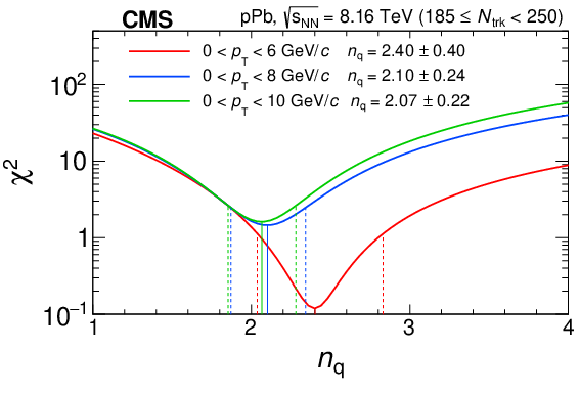
png pdf |
Figure 9:
The $ \chi^2 $ scan.} The $ \chi^2 $ of the f$_0$(980) elliptic flow data with respect to the NCQ scaling parameterization, scanned in steps of $ n_\mathrm{q} $. The three curves correspond to using f$_0$(980) data for $ p_{\mathrm{T}} < $ 6, 8, and 10 GeV/$c$, respectively. |

png pdf |
Figure 10:
Exclusion significances for $ n_{\mathrm{q}}= $ 4.} Same as Fig. 4 but using $ \mathrm{f}_0(980) v_2^{\text{sub}} $ data within the restricted ranges $ p_{\mathrm{T}} < $ 8 GeV/$c$ (upper) and $ p_{\mathrm{T}} < $ 6 GeV/$c$ (lower). |
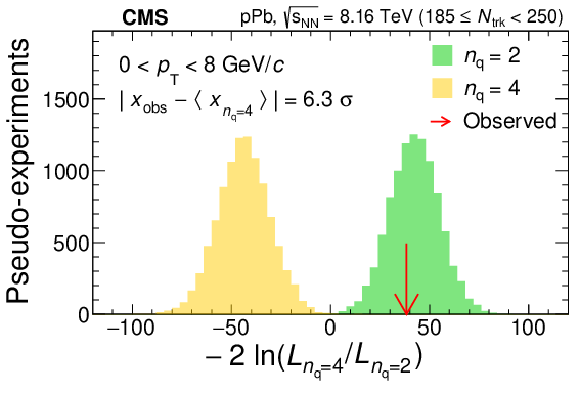
png pdf |
Figure 10-a:
Exclusion significances for $ n_{\mathrm{q}}= $ 4.} Same as Fig. 4 but using $ \mathrm{f}_0(980) v_2^{\text{sub}} $ data within the restricted ranges $ p_{\mathrm{T}} < $ 8 GeV/$c$ (upper) and $ p_{\mathrm{T}} < $ 6 GeV/$c$ (lower). |
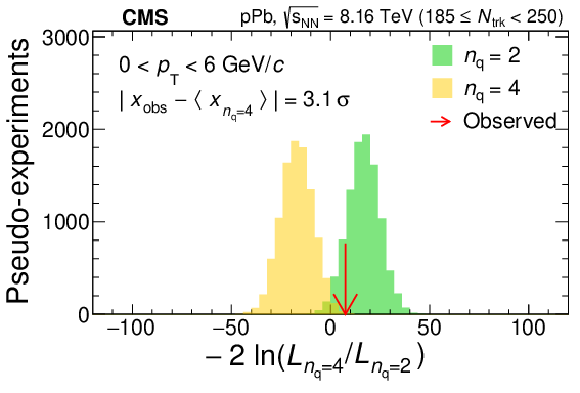
png pdf |
Figure 10-b:
Exclusion significances for $ n_{\mathrm{q}}= $ 4.} Same as Fig. 4 but using $ \mathrm{f}_0(980) v_2^{\text{sub}} $ data within the restricted ranges $ p_{\mathrm{T}} < $ 8 GeV/$c$ (upper) and $ p_{\mathrm{T}} < $ 6 GeV/$c$ (lower). |
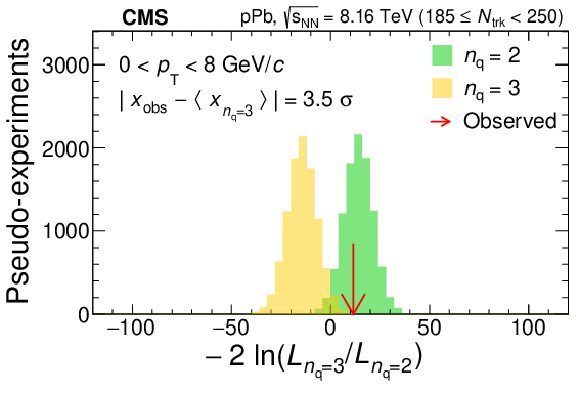
png pdf |
Figure 11:
Exclusion significance for $ n_{\mathrm{q}}= $ 3.} The expected log-likelihood ratio distributions for $ n_{\mathrm{q}}= $ 2 vs.\ 3 hypotheses from the pseudo-experiments and the observed value for the f$_0$(980) in data in the $ p_{\mathrm{T}} < $ 8 GeV/$c$ range. |
| Tables | |

png pdf |
Table 1:
Sources and magnitudes of the uncertainties in the extracted $ n_{\mathrm{q}} $ of the f$_0$(980) state in the range $ p_{\mathrm{T}} < $ 10 GeV/$c$. |
| Summary |
| The f$_0$(980) state is observed in the $ \pi^{+}\pi^{-} $ invariant mass distribution of high-multiplicity proton-lead collisions at $ \sqrt{\smash[b]{s_{_{\mathrm{NN}}}}}= $ 8.16 TeV, using data collected by the CMS experiment in 2016 and corresponding to an integrated luminosity of 186$\,\text{nb}^{-1}$. The elliptic flow anisotropy $ v_{2} $ of the f$_0$(980) state is measured as a function of $ p_{\mathrm{T}} $ up to 10 GeV/$c$, with respect to the second-order harmonic plane reconstructed from forward/backward energy flow. After subtracting the nonflow contamination, evaluated from $ \mathrm{K^0_S} $ measurements, we obtain the corrected $ v_2^{\text{sub}} $ observable. By comparing the $ \mathrm{f}_0(980) v_2^{\text{sub}} $ to those of $ \mathrm{K^0_S} $, $ \Lambda $, $ \Xi^{-} $, and $ \Omega $ under the number-of-constituent-quarks scaling hypothesis, we rule out the hypotheses that the f$_0$(980) is a tetraquark state or a $ {\mathrm{K}\overline{\mathrm{K}}} $ molecule, in favor of an ordinary $ \mathrm{q}\bar{\mathrm{q}} $ meson hypothesis, at 7.7 standard deviations (6.3 or 3.1 standard deviations, respectively, if only a restricted range of $ p_{\mathrm{T}} < $ 8 or 6 GeV/$c$ is considered). The f$_0$(980) data in the $ p_{\mathrm{T}} < $ 8 GeV/$c$ range are found to disfavor a quark-antiquark-gluon hybrid state at 3.5 standard deviations. The number of constituent quarks of the f$_0$(980) state, as extracted from a fit to the $ v_2^{\text{sub}} $ data, is consistent with the value of 2, characteristic of an ordinary meson. Consequently, we find strong evidence that the f$_0$(980) hadron is a normal quark-antiquark state. We believe that the results reported in this paper present a clear solution to a half-a-century-old puzzle. The experimental determination of the quark content of the f$_0$(980) state with high confidence, using this novel approach, is expected to stimulate further experimental investigations as well as theoretical studies. It paves the way for studies of other exotic hadron candidates using the collective flow scaling approach in high-multiplicity proton-nucleus and heavy ion collisions. |
| References | ||||
| 1 | M. Gell-Mann | A schematic model of baryons and mesons | PL 8 (1964) 214 | |
| 2 | G. Zweig | An SU$ _3 $ model for strong interaction symmetry and its breaking; Version 2 | Developments in the Quark Theory of Hadrons. Vol. 1. 1964-1978 link |
|
| 3 | R. L. Jaffe | Perhaps a stable dihyperon | PRL 38 (1977) 195 | |
| 4 | R. L. Jaffe | Exotica | Phys. Rept. 409 (2005) 1 | hep-ph/0409065 |
| 5 | Belle Collaboration | Observation of a narrow charmonium-like state in exclusive $ B^\pm \to K^\pm \pi^+ \pi^- J/\psi $ decays | PRL 91 (2003) 262001 | hep-ex/0309032 |
| 6 | LHCb Collaboration | Observation of an exotic narrow doubly charmed tetraquark | Nature Phys. 18 (2022) 751 | 2109.01038 |
| 7 | A. Esposito, A. Pilloni, and A. D. Polosa | Multiquark resonances | Phys. Rept. 668 (2017) 1 | 1611.07920 |
| 8 | S. L. Olsen, T. Skwarnicki, and D. Zieminska | Nonstandard heavy mesons and baryons: experimental evidence | Rev. Mod. Phys. 90 (2018) 015003 | 1708.04012 |
| 9 | S. D. Protopopescu et al. | $ \pi\pi $ partial wave analysis from reactions $ \pi^+ p \to \pi^+ \pi^- \Delta^{++} $ and $ \pi^+ p \to K^+ K^- \Delta^{++} $ at 7.1 GeVc | PRD 7 (1973) 1279 | |
| 10 | B. Hyams et al. | $ \pi\pi $ phase shift analysis from 600 to 1900 MeV | NPB 64 (1973) 134 | |
| 11 | G. Grayer et al. | High statistics study of the reaction $ \pi^- p \to \pi^-\pi^+ n $: apparatus, method of analysis, and general features of results at 17 GeVc | NPB 75 (1974) 189 | |
| 12 | R. L. Jaffe | Multi-quark hadrons. 1. phenomenology of ($ Q^2{\bar Q}^2 $) mesons | PRD 15 (1977) 267 | |
| 13 | J. D. Weinstein and N. Isgur | $ \mathrm{K}\overline{\mathrm{K}} $ molecules | PRD 41 (1990) 2236 | |
| 14 | C. Amsler and N. A. Tornqvist | Mesons beyond the naive quark model | Phys. Rept. 389 (2004) 61 | |
| 15 | D. V. Bugg | Four sorts of meson | Phys. Rept. 397 (2004) 257 | hep-ex/0412045 |
| 16 | E. Klempt and A. Zaitsev | Glueballs, hybrids, multiquarks. experimental facts versus QCD inspired concepts | Phys. Rept. 454 (2007) 1 | 0708.4016 |
| 17 | A. Deandrea et al. | The $ \mathrm{s}\overline{\mathrm{s}} $ and $ \mathrm{K}\overline{\mathrm{K}} $ nature of f$_0$(980) in $ \mathrm{D}_{s} $ decays | PLB 502 (2001) 79 | hep-ph/0012120 |
| 18 | Particle Data Group Collaboration | Review of Particle Physics | PTEP 2022 (2022) 083C01 | |
| 19 | CMS Collaboration | Evidence for \HepParticleResonanceX3872 in Pb-Pb collisions and studies of its prompt production at $ \sqrt{\smash[b]{s_{_{\mathrm{NN}}}}}= $ 5.02 TeV | PRL 128 (2022) 032001 | CMS-HIN-19-005 2102.13048 |
| 20 | S. T. Butler and C. A. Pearson | Deuterons from high-energy proton bombardment of matter | PR 129 (1963) 836 | |
| 21 | C. B. Dover, U. W. Heinz, E. Schnedermann, and J. Zimanyi | Relativistic coalescence model for high-energy nuclear collisions | Phys. Rev. C 44 (1991) 1636 | |
| 22 | R. J. Fries, V. Greco, and P. Sorensen | Coalescence models for hadron formation from quark gluon plasma | Ann. Rev. Nucl. Part. Sci. 58 (2008) 177 | 0807.4939 |
| 23 | R. C. Hwa and C. B. Yang | Scaling behavior at high $ p_{\mathrm{T}} $ and the p/$ \pi $ ratio | Phys. Rev. C 67 (2003) 034902 | nucl-th/0211010 |
| 24 | R. J. Fries, B. Muller, C. Nonaka, and S. A. Bass | Hadronization in heavy ion collisions: recombination and fragmentation of partons | PRL 90 (2003) 202303 | nucl-th/0301087 |
| 25 | V. Greco, C. M. Ko, and P. Levai | Parton coalescence and the antiproton/pion anomaly at RHIC | PRL 90 (2003) 202302 | nucl-th/0301093 |
| 26 | J.-Y. Ollitrault | Anisotropy as a signature of transverse collective flow | PRD 46 (1992) 229 | |
| 27 | CMS Collaboration | Observation of long-range near-side angular correlations in proton-proton collisions at the LHC | JHEP 09 (2010) 091 | CMS-QCD-10-002 1009.4122 |
| 28 | ATLAS Collaboration | Observation of long-range elliptic azimuthal anisotropies in $ \sqrt{s}= $ 13 and 2.76 TeV pp collisions with the ATLAS detector | PRL 116 (2016) 172301 | 1509.04776 |
| 29 | CMS Collaboration | Measurement of long-range near-side two-particle angular correlations in pp collisions at $ \sqrt{s} = $ 13 TeV | PRL 116 (2016) 172302 | CMS-FSQ-15-002 1510.03068 |
| 30 | CMS Collaboration | Evidence for collectivity in pp collisions at the LHC | PLB 765 (2017) 193 | CMS-HIN-16-010 1606.06198 |
| 31 | CMS Collaboration | Observation of long-range near-side angular correlations in proton-lead collisions at the LHC | PLB 718 (2013) 795 | CMS-HIN-12-015 1210.5482 |
| 32 | ALICE Collaboration | Long-range angular correlations on the near and away side in $ \mathrm{p}\mathrm{Pb} $ collisions at $ \sqrt{\smash[b]{s_{_{\mathrm{NN}}}}}= $ 5.02 TeV | PLB 719 (2013) 29 | 1212.2001 |
| 33 | ATLAS Collaboration | Observation of associated near-side and away-side long-range correlations in $ \sqrt{\smash[b]{s_{_{\mathrm{NN}}}}}= $ 5.02 TeV proton-lead collisions with the ATLAS detector | PRL 110 (2013) 182302 | 1212.5198 |
| 34 | CMS Collaboration | Multiplicity and transverse momentum dependence of two- and four-particle correlations in $ \mathrm{p}\mathrm{Pb} $ and PbPb collisions | PLB 724 (2013) 213 | CMS-HIN-13-002 1305.0609 |
| 35 | ATLAS Collaboration | Measurement of long-range pseudorapidity correlations and azimuthal harmonics in $ \sqrt{\smash[b]{s_{_{\mathrm{NN}}}}}= $ 5.02 TeV proton-lead collisions with the ATLAS detector | Phys. Rev. C 90 (2014) 044906 | 1409.1792 |
| 36 | CMS Collaboration | Long-range two-particle correlations of strange hadrons with charged particles in $ \mathrm{p}\mathrm{Pb} $ and PbPb collisions at LHC energies | PLB 742 (2015) 200 | CMS-HIN-14-002 1409.3392 |
| 37 | CMS Collaboration | Evidence for collective multiparticle correlations in $ \mathrm{p}\mathrm{Pb} $ collisions | PRL 115 (2015) 012301 | CMS-HIN-14-006 1502.05382 |
| 38 | LHCb Collaboration | Measurements of long-range near-side angular correlations in $ \sqrt{\smash[b]{s_{_{\mathrm{NN}}}}}= $ 5 TeV proton-lead collisions in the forward region | PLB 762 (2016) 473 | 1512.00439 |
| 39 | A. Gu, T. Edmonds, J. Zhao, and F. Wang | Elliptical flow coalescence to identify the f$_0$(980) content | Phys. Rev. C 101 (2020) 024908 | 1902.07152 |
| 40 | A. M. Poskanzer and S. A. Voloshin | Methods for analyzing anisotropic flow in relativistic nuclear collisions | Phys. Rev. C 58 (1998) 1671 | nucl-ex/9805001 |
| 41 | D. Molnar and S. A. Voloshin | Elliptic flow at large transverse momenta from quark coalescence | PRL 91 (2003) 092301 | nucl-th/0302014 |
| 42 | L. Maiani, A. D. Polosa, V. Riquer, and C. A. Salgado | Counting valence quarks at RHIC and LHC | PLB 645 (2007) | hep-ph/0606217 |
| 43 | ExHIC Collaboration | Multi-quark hadrons from heavy ion collisions | PRL 106 (2011) 212001 | 1011.0852 |
| 44 | A. Gu and F. Wang | Transverse momentum spectra of f$_0$(980) from coalescence model | PLB 848 (2024) 138399 | 2306.08584 |
| 45 | ALICE Collaboration | Observation of abnormal suppression of f$_0$(980) production in $ \mathrm{p}\mathrm{Pb} $ collisions at $ \sqrt{\smash[b]{s_{_{\mathrm{NN}}}}} = $ 5.02 TeV | 2311.11786 | |
| 46 | STAR Collaboration | Particle type dependence of azimuthal anisotropy and nuclear modification of particle production in Au + Au collisions at $ \sqrt{\smash[b]{s_{_{\mathrm{NN}}}}} = $ 200 GeV | PRL 92 (2004) 052302 | nucl-ex/0306007 |
| 47 | PHENIX Collaboration | Scaling properties of azimuthal anisotropy in Au+Au and Cu+Cu collisions at $ \sqrt{\smash[b]{s_{_{\mathrm{NN}}}}} = $ 200 GeV | PRL 98 (2007) 162301 | nucl-ex/0608033 |
| 48 | ALICE Collaboration | Elliptic flow of identified hadrons in Pb-Pb collisions at $ \sqrt{\smash[b]{s_{_{\mathrm{NN}}}}}= $ 2.76 TeV | JHEP 06 (2015) 190 | 1405.4632 |
| 49 | ALICE Collaboration | Anisotropic flow of identified particles in Pb-Pb collisions at $ \sqrt{\smash[b]{s_{_{\mathrm{NN}}}}}= $ 5.02 TeV | JHEP 09 (2018) 006 | 1805.04390 |
| 50 | CMS Collaboration | Elliptic flow of charm and strange hadrons in high-multiplicity $ \mathrm{p}\mathrm{Pb} $ collisions at $ \sqrt{\smash[b]{s_{_{\mathrm{NN}}}}} = $ 8.16 TeV | PRL 121 (2018) 082301 | CMS-HIN-17-003 1804.09767 |
| 51 | CMS Collaboration | HEPData record for this analysis | link | |
| 52 | CMS Collaboration | Description and performance of track and primary-vertex reconstruction with the CMS tracker | JINST 9 (2014) P10009 | CMS-TRK-11-001 1405.6569 |
| 53 | CMS Collaboration | Strategies and performance of the CMS silicon tracker alignment during LHC Run 2 | NIM A 1037 (2022) 166795 | CMS-TRK-20-001 2111.08757 |
| 54 | CMS Collaboration | Performance of the CMS Level-1 trigger in proton-proton collisions at $ \sqrt{s} = $ 13 TeV | JINST 15 (2020) P10017 | CMS-TRG-17-001 2006.10165 |
| 55 | CMS Collaboration | The CMS trigger system | JINST 12 (2017) P01020 | CMS-TRG-12-001 1609.02366 |
| 56 | CMS Collaboration | The CMS experiment at the CERN LHC | JINST 3 (2008) S08004 | |
| 57 | CMS Collaboration | Development of the CMS detector for the CERN LHC Run 3 | Accepted by JINST, 2023 | CMS-PRF-21-001 2309.05466 |
| 58 | CMS Collaboration | Observation of correlated azimuthal anisotropy Fourier harmonics in $ pp $ and $ p+Pb $ collisions at the LHC | PRL 120 (2018) 092301 | CMS-HIN-16-022 1709.09189 |
| 59 | V. Weisskopf and E. P. Wigner | Berechnung der nat\"urlichen linienbreite auf grund der Diracschen lichttheorie | Z. Phys. 63 (1930) 54 | |
| 60 | CMSnoop | Coulomb wave functions | \hrefM.~H. Hull and G.~Breit, , . Springer Berlin Heidelberg, Berlin, Heidelberg, 1959 link |
|
| 61 | STAR Collaboration | $ \rho^0 $ production and possible modification in Au+Au and p+p collisions at $ \sqrt{\smash[b]{s_{_{\mathrm{NN}}}}} = $ 200 GeV | PRL 92 (2004) 092301 | nucl-ex/0307023 |
| 62 | STAR Collaboration | NCQ scaling of f$_0$(980) elliptic flow in 200 GeV Au+Au collisions by STAR and its constituent quark content | Eur. Phys. J. Web Conf. 259 (2022) 10013 | 2202.01618 |
| 63 | M. Gyulassy and X.-N. Wang | HIJING 1.0: A Monte Carlo program for parton and particle production in high-energy hadronic and nuclear collisions | Comput. Phys. Commun. 83 (1994) 307 | nucl-th/9502021 |
| 64 | GEANT4 Collaboration | GEANT 4---a simulation toolkit | NIM A 506 (2003) 250 | |
| 65 | P. T. Matthews and A. Salam | Relativistic theory of unstable particles. II | PR 115 (1959) 1079 | |
| 66 | R. A. Kycia and S. Jadach | Relativistic Voigt profile for unstable particles in high energy physics | J. Math. Anal. Appl. 463 (2018) 1040 | 1711.09304 |

|
Compact Muon Solenoid LHC, CERN |

|

|

|

|

|

|